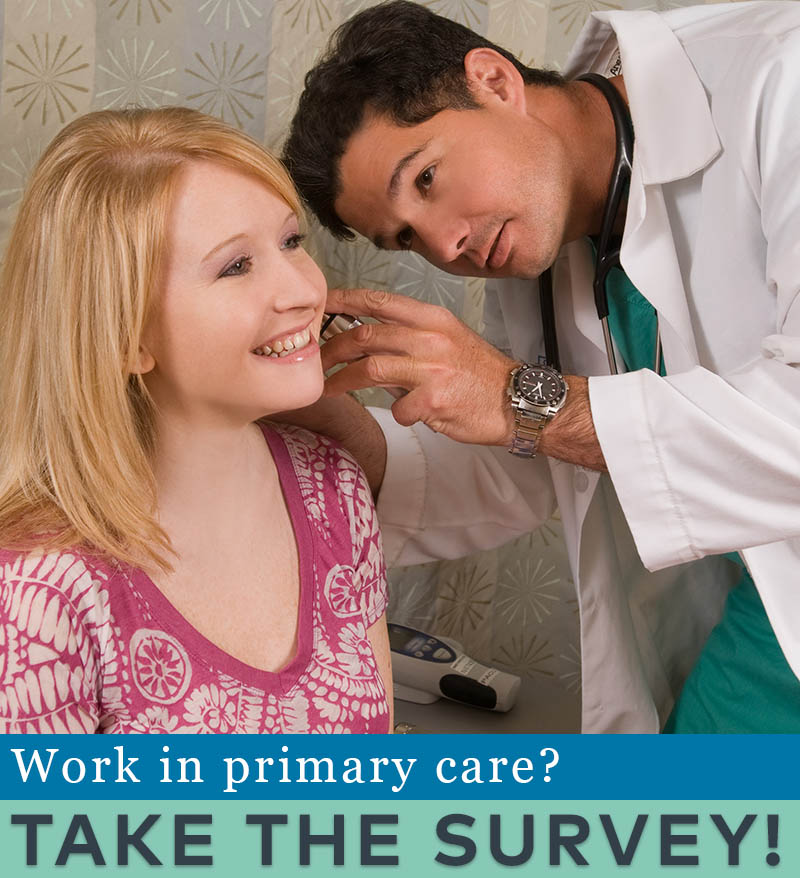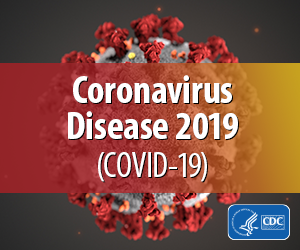You are looking at an archived version of our site. Please visit thepcc.org for a fresh, new experience!
You are here: Array » Primary Care & COV ...
Primary Care & COVID-19: Week 11 Surveys
Check back weekly for the latest survey results and updates.
For last week's data, see Week 10 Results.
Who replied to the surveys?
The Larry A. Green Center is now fielding two separate surveys: one to primary care clinicians, and a second to patients 18 years and older. Both surveys are voluntary and anonymous, using national convenience samples to better understand the impact of COVID-19 on primary care.
The week’s clinician survey (Series 11) received just over 500 responses from 48 states. The majority of surveyed clinicians continued to come from family medicine (65%), followed by internal medicine (18%), pediatrics (6%), geriatrics (5%), and other (5%). Nearly a third work in very small settings (1-3 clinicians) and another quarter work in settings with 4-9 clinicians. Thirty-one percent work in patient-centered medical homes.
Responses to Series 11 of the clinician survey were collected May 22-26, 2020.
Total responses: 506.
Series 1 of the patient survey was fielded over a week via a public online posting, and received 2,250 responses. Patients varied in terms of: age (one third were 18-25 years; another third were over 50); education (34% high school degree, 47% college degree, 15% graduate degree); and income (44% less than $50,000 household income, 7% greater than $150,000 household income). Only 42% of those surveyed had full-time employment, and another 14% were employed part-time. A fifth of respondents lost their employment during the pandemic.
Responses to Series 1 of the patient survey were collected May 4-11, 2020.
Total responses: 2,250.
Results at a glance
Essential care is not only being delayed by practices; it’s being actively avoided by patients. While 70% of primary care clinicians say their practice is limiting wellness and chronic care visits, a greater number (84%) say patients are independently delaying their visits. This is backed up by patient reports: Nearly a quarter of surveyed patients say they were sick or injured but actively avoided medical care. And 42% say they plan to delay care until they have a serious concern.
This delayed and avoided care—both for existing chronic conditions and new mental health strain—is posing a looming threat of deferred illness. A fifth of patients say they are overdue for chronic care visits, and a third of patients say they are overdue for wellness visits and preventative care. New mental health concerns are also growing. Over half of patients say they have trouble with feelings of isolation/loneliness; and nearly half (48%) say they are struggling with anxiety/depression.
Primary care has an essential role to play—for both society at large and for individual patients. Primary care practices continues to serve on the frontlines of diagnosing and testing for the virus, and their pro-active outreach is strengthening the country’s public health response: Nearly three-quarters of patient-reported contact with their primary care practices was the result of outreach by the practice to check on patients. At the same time, patients see personal value in their connection with primary care. Over 70% have a usual source of care and a “doctor they can trust”, and two-thirds feel that their “doctor helps them make sense of what’s going on with them.”
Barriers to virtual care exist for many patients, not just a few. Telehealth is playing an important role in helping to provide care during the pandemic, but barriers to telehealth exist for many patients—not just the most vulnerable. Nearly a third (29%) of surveyed patients say they do not have the broadband access required to support most digital health care platforms. And another 28% say they do not have tablets or computers at home to support digital health care. That likely explains why the majority (58%) of patient-reported care interactions were phone contacts and 27% of practice report no use of video visits. Relatedly, over a third (38%) of primary care clinicians still say that the majority of their care delivered is not reimbursable.
Some financial support is making its way to primary care, but not enough. And this is likely to be felt by both clinicians and patients. Primary care clinicians report receiving some federal and state support: 38% say their practice received help through the Paycheck Protection Program; 12% through another Small Business Administration loan; 8% from through their state government; and 10% from a parent organization. Still, the number reporting layoffs and furloughs (45%), deferred or skipped salaries (28%) and temporary closures (14%) remains constant. Such financial hardship risks impacting clinicians and patients alike: 83% of patients say they would feel distress at the loss of a relationship with their doctor. And that sentiment refers only to the loss of their personal relationship. The ability—or inability—to access care elsewhere is yet another likely challenge for patients in the face of increasing closures.
Learn more: Download:
Both include select open-ended answers to survey questions.
Voices from the Primary Care Front Lines
Both patients and clinicians fear the short- and long-term impact of delaying care.
I have seen several patients suffer [as a result of not coming in] either due to loss of insurance or fear of COVID. (Primary care clinician in California)
I have a blood infection but will not see my doctor because I'll be admitted for IV antibiotics. After 2 weeks I'll be moved to a nursing home and I'm afraid of catching COVID-19. (Primary care patient)
I need to go for my heart but I’m scared of extra contact because I have to go back to work and I have 3 out of 5 kids at home have asthma induced from illness usually respiratory (flu & colds). (Primary care patient)
Mental stress related to the pandemic continues to take a toll.
Other than 99% of the time I sit in a 12x12 room, 23 hours a day ... everything is normal. (Primary care patient)
I have seen more morbidity and mortality in my community from social isolation than from COVID (mental health, poor control of chronic disease, preventable deaths by delaying/avoiding care). (Primary care clinician in Virginia)
Not being able to socialize/gather with my friends for games and activities. So desolate. (Primary care patient)
Telehealth continues to have its challenges for both clinicians and patients and for various reasons.
Video is better than phone but most of our patients aren't able to use it. My home internet is useless so I am only available when I drive to my office. I would be able to serve my patients better if quality internet capacity was extended to rural areas. It takes a lot of bandwidth to load a secure electronic record, and more to do a video visit. (Primary care clinician in Michigan)
Difficulties for elderly to obtain video visits – video visits often allow better assessments of "Gestalt" and of specific pain syndromes. Lack of monitoring equipment at home (BP, pulse ox, scales) and lack of payment [make this hard]. (Primary care clinician in New York)
Providers took pay cuts in an effort to stay open. The demand for telehealth is booming. Reimbursement starting to improve but has to be for the long haul until a vaccine is available. It is great that insurers are covering telephone calls. (Primary care clinician in Pennsylvania)
Clinicians continue to be pummeled by sharply decreasing revenue at their clinics.
Fee-for-service does not support healing relationships. We need to get away from transactional care. (Primary care clinician in Oregon)
May is going to be worse than April. My practice revenue is down 50% and I am using my personal fund to pay expenses. (Primary care clinician in Kansas)
People rely on us for information. There is a lot of unreimbursed work, such as answering messages, simplifying COVID information, etc. All of this unpaid work is what helps support a public health response. (Primary care clinician in Minnesota)
| Attachment | Size |
|---|---|
| 672.39 KB | |
| 790.71 KB |

Are you a physician, nurse practitioner, or PA working in primary care?
Help PCC and the Larry A. Green Center track how your practice is responding to the COVID-19 outbreak by completing the Green Center's occasional survey.
The regular surveys are no longer being conducted.
COVID-19 Updates
May 9, 2022 | Primary Care Collaborative
April 19, 2022 | Primary Care Collaborative
April 19, 2022 | Primary Care Collaborative
March 7, 2022 | STAT
February 27, 2022
- 1 of 39
- next ›

Recent News
August 16, 2024
August 12, 2024
July 16, 2024
May webinar highlights: “The Commercial Market: Alternative Payment Models for Primary Care” Nate Murray explains w… https://t.co/KX9Wi2w6oY —
2 years 6 months ago
@CMSinnovates’ primary care strategy is rooted in a 2021 @theNASEM’s report which called #primarycare “foundational… https://t.co/glbPxvCysg —
2 years 6 months ago
@CMSinnovates has a new #primarycare strategy, envisioning “ACO-based primary care model tests that may focus on pr… https://t.co/aJGF1z411l —
2 years 6 months ago
- Page 1
- ››
Secondary menu
Copyright © 2024 Primary Care Collaborative





